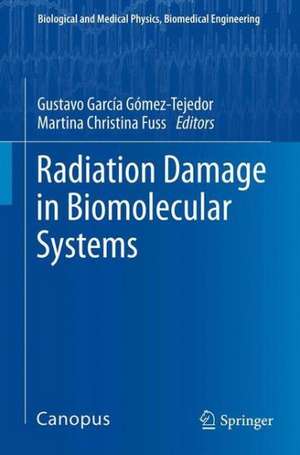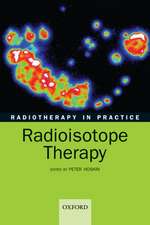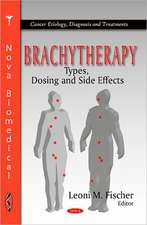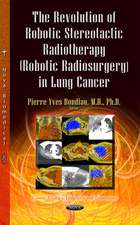Radiation Damage in Biomolecular Systems: Biological and Medical Physics, Biomedical Engineering
Editat de Gustavo García Gómez-Tejedor, Martina Christina Fussen Limba Engleză Paperback – 23 feb 2014
Pioneering experiments done by Sanche and co-workers in 2000 showed that low-energy secondary electrons, which are abundantly generated along radiation tracks, are primarily responsible for radiation damage through successive interactions with the molecular constituents of the medium. Apart from ionizing processes, which are usually related to radiation damage, below the ionization level low-energy electrons can induce molecular fragmentation via dissociative processes such as internal excitation and electron attachment. This prompted collaborative projects between different research groups from European countries together with other specialists from Canada, the USA and Australia.
This book summarizes the advances achieved by these research groups after more than ten years of studies on radiation damage in biomolecular systems.
An extensive Part I deals with recent experimental and theoretical findings on radiation induced damage at the molecular level. It includes many contributions on electron and positron collisions with biologically relevant molecules. X-ray and ion interactions are also covered. Part II addresses different approaches to radiation damage modelling. In Part III biomedical aspects of radiation effects are treated on different scales. After the physics-oriented focus of the previous parts, there is a gradual transition to biology and medicine with the increasing size of the object studied. Finally, Part IV is dedicated to current trends and novel techniques in radiation reserach and the applications hence arising. It includes new developments in radiotherapy and related cancer therapies, as well as technical optimizations of accelerators andtotally new equipment designs, giving a glimpse of the near future of radiation-based medical treatments.
| Toate formatele și edițiile | Preț | Express |
|---|---|---|
| Paperback (1) | 954.31 lei 6-8 săpt. | |
| SPRINGER NETHERLANDS – 23 feb 2014 | 954.31 lei 6-8 săpt. | |
| Hardback (1) | 959.19 lei 6-8 săpt. | |
| SPRINGER NETHERLANDS – 5 ian 2012 | 959.19 lei 6-8 săpt. |
Din seria Biological and Medical Physics, Biomedical Engineering
- 5%
 Preț: 1110.32 lei
Preț: 1110.32 lei - 18%
 Preț: 1006.55 lei
Preț: 1006.55 lei - 18%
 Preț: 960.78 lei
Preț: 960.78 lei - 18%
 Preț: 704.11 lei
Preț: 704.11 lei - 18%
 Preț: 967.40 lei
Preț: 967.40 lei - 18%
 Preț: 948.92 lei
Preț: 948.92 lei - 15%
 Preț: 641.71 lei
Preț: 641.71 lei - 15%
 Preț: 644.95 lei
Preț: 644.95 lei - 15%
 Preț: 665.08 lei
Preț: 665.08 lei - 18%
 Preț: 1669.16 lei
Preț: 1669.16 lei - 18%
 Preț: 941.05 lei
Preț: 941.05 lei - 18%
 Preț: 956.81 lei
Preț: 956.81 lei - 18%
 Preț: 950.21 lei
Preț: 950.21 lei - 15%
 Preț: 636.80 lei
Preț: 636.80 lei - 18%
 Preț: 947.50 lei
Preț: 947.50 lei - 15%
 Preț: 636.80 lei
Preț: 636.80 lei -
 Preț: 397.01 lei
Preț: 397.01 lei - 18%
 Preț: 1236.99 lei
Preț: 1236.99 lei - 15%
 Preț: 644.49 lei
Preț: 644.49 lei - 18%
 Preț: 946.55 lei
Preț: 946.55 lei - 15%
 Preț: 712.22 lei
Preț: 712.22 lei - 18%
 Preț: 952.89 lei
Preț: 952.89 lei - 18%
 Preț: 944.36 lei
Preț: 944.36 lei - 18%
 Preț: 1228.29 lei
Preț: 1228.29 lei - 5%
 Preț: 1422.67 lei
Preț: 1422.67 lei - 18%
 Preț: 1393.27 lei
Preț: 1393.27 lei - 15%
 Preț: 651.19 lei
Preț: 651.19 lei - 18%
 Preț: 953.65 lei
Preț: 953.65 lei - 18%
 Preț: 955.88 lei
Preț: 955.88 lei - 15%
 Preț: 644.95 lei
Preț: 644.95 lei - 5%
 Preț: 1098.48 lei
Preț: 1098.48 lei - 18%
 Preț: 959.19 lei
Preț: 959.19 lei - 15%
 Preț: 643.65 lei
Preț: 643.65 lei - 5%
 Preț: 1159.16 lei
Preț: 1159.16 lei - 5%
 Preț: 1102.67 lei
Preț: 1102.67 lei - 18%
 Preț: 952.09 lei
Preț: 952.09 lei - 18%
 Preț: 946.55 lei
Preț: 946.55 lei - 18%
 Preț: 952.09 lei
Preț: 952.09 lei - 15%
 Preț: 703.20 lei
Preț: 703.20 lei - 18%
 Preț: 953.65 lei
Preț: 953.65 lei - 5%
 Preț: 1008.45 lei
Preț: 1008.45 lei - 15%
 Preț: 644.82 lei
Preț: 644.82 lei - 18%
 Preț: 956.03 lei
Preț: 956.03 lei - 15%
 Preț: 647.40 lei
Preț: 647.40 lei
Preț: 954.31 lei
Preț vechi: 1163.80 lei
-18% Nou
Puncte Express: 1431
Preț estimativ în valută:
182.61€ • 198.98$ • 153.87£
182.61€ • 198.98$ • 153.87£
Carte tipărită la comandă
Livrare economică 23 aprilie-07 mai
Preluare comenzi: 021 569.72.76
Specificații
ISBN-13: 9789400795822
ISBN-10: 9400795823
Pagini: 524
Ilustrații: XIV, 510 p.
Dimensiuni: 155 x 235 x 28 mm
Greutate: 0.7 kg
Ediția:2012
Editura: SPRINGER NETHERLANDS
Colecția Springer
Seria Biological and Medical Physics, Biomedical Engineering
Locul publicării:Dordrecht, Netherlands
ISBN-10: 9400795823
Pagini: 524
Ilustrații: XIV, 510 p.
Dimensiuni: 155 x 235 x 28 mm
Greutate: 0.7 kg
Ediția:2012
Editura: SPRINGER NETHERLANDS
Colecția Springer
Seria Biological and Medical Physics, Biomedical Engineering
Locul publicării:Dordrecht, Netherlands
Public țintă
ResearchCuprins
Preface.- Acronyms.
Part I Radiation Induced Damage at the Molecular Level
1: Nanoscale Dynamics of Radiosensitivity: Role of Low Energy Electrons.- 2: The Role of Secondary Electrons in Radiation Damage.- 3: Electron Transfer-Induced Fragmentation in (Bio)Molecules by Atom-Molecule.- 4: Following Resonant Compound States after Electron Attachment.- 5: Electron–Biomolecule Collision Studies Using the Schwinger Multichannel Method.- 6: Resonances in Electron Collisions with Small Biomolecules Using the R-Matrix Method.- 7: A Multiple-Scattering Approach to Electron Collisions with Small Molecular Clusters.- 8: Positronium Formation and Scattering from Biologically Relevant Molecules.- 9: Total Cross Sections for Positron Scattering from Bio-Molecules.- 10: Soft X-ray Interaction with Organic Molecules of Biological Interest.- 11: Ion-Induced Radiation Damage in Biomolecular Systems.- 12: Theory and Calculation of Stopping Cross Sections of Nucleobases for Swift Ions.
Part II Modelling Radiation Damage
13: Monte Carlo Methods to Model Radiation Interactions and Induced Damage.- 14: Positron and Electron Interactions and Transport in Biological Media.- 15: Energy Loss of Swift Protons in LiquidWater: Role of Optical Data Input and Extension Algorithms.- 16: Quantum-Mechanical Contributions to Numerical Simulations of Charged Particle Transport at the DNA Scale.- 17: Multiscale Approach to Radiation Damage Induced by Ions.- 18: Track-Structure Monte Carlo Modelling in X-ray and Megavoltage Photon Radiotherapy.- 19: Simulation of Medical Linear Accelerators with PENELOPE.
Part III Biomedical Aspects of Radiation Effects
20: Repair of DNA Double-Strand Breaks.- 21: Differentially Expressed Genes Associated with Low-Dose Gamma Radiation.- 22: Chromosome Aberrations by Heavy Ions.- 23: Spatial and Temporal Aspects of Radiation Response in Cell and Tissue Models.- 24: Therapeutic Applications of Ionizing Radiations.- 25: OptimizedMolecular Imaging through Magnetic Resonance for Improved Target Definition in Radiation Oncology.
Part IV Future Trends in Radiation Research and its Applications
26: Medical Applications of Synchrotron Radiation.- 27: Photodynamic Therapy.- 28: Auger Emitting Radiopharmaceuticals for Cancer Therapy.- 29: Using a matrix approach in nonlinear beam dynamics for optimizing beam spot size.- 30 Future Particle Accelerator Developments for Radiation Therapy.Part III Biomedical Aspects of Radiation Effects
20: Repair of DNA Double-Strand Breaks.- 21: Differentially Expressed Genes Associated with Low-Dose Gamma Radiation.- 22: Chromosome Aberrations by Heavy Ions.- 23: Spatial and Temporal Aspects of Radiation Response in Cell and Tissue Models.- 24: Therapeutic Applications of Ionizing Radiations.- 25: Optimized Molecular Imaging through Magnetic Resonance for Improved Target Definition in Radiation Oncology.
Part IV Future Trends in Radiation Research and its Applications
26: Medical Applications of Synchrotron Radiation.- 27: Photodynamic Therapy.- 28: Auger Emitting Radiopharmaceuticals for Cancer Therapy.- 29: Using a matrix approach in nonlinear beam dynamics for optimizing beam spot size.- 30 Future Particle Accelerator Developments for Radiation Therapy.Part IV Future Trends in Radiation Research and its Applications
26: Medical Applications of Synchrotron Radiation.- 27: Photodynamic Therapy.- 28: Auger Emitting Radiopharmaceuticals for Cancer Therapy.- 29: Using a matrix approach in nonlinear beam dynamics for optimizing beam spot size.- 30: Future Particle Accelerator Developments for Radiation Therapy.
Part I Radiation Induced Damage at the Molecular Level
1: Nanoscale Dynamics of Radiosensitivity: Role of Low Energy Electrons.- 2: The Role of Secondary Electrons in Radiation Damage.- 3: Electron Transfer-Induced Fragmentation in (Bio)Molecules by Atom-Molecule.- 4: Following Resonant Compound States after Electron Attachment.- 5: Electron–Biomolecule Collision Studies Using the Schwinger Multichannel Method.- 6: Resonances in Electron Collisions with Small Biomolecules Using the R-Matrix Method.- 7: A Multiple-Scattering Approach to Electron Collisions with Small Molecular Clusters.- 8: Positronium Formation and Scattering from Biologically Relevant Molecules.- 9: Total Cross Sections for Positron Scattering from Bio-Molecules.- 10: Soft X-ray Interaction with Organic Molecules of Biological Interest.- 11: Ion-Induced Radiation Damage in Biomolecular Systems.- 12: Theory and Calculation of Stopping Cross Sections of Nucleobases for Swift Ions.
Part II Modelling Radiation Damage
13: Monte Carlo Methods to Model Radiation Interactions and Induced Damage.- 14: Positron and Electron Interactions and Transport in Biological Media.- 15: Energy Loss of Swift Protons in LiquidWater: Role of Optical Data Input and Extension Algorithms.- 16: Quantum-Mechanical Contributions to Numerical Simulations of Charged Particle Transport at the DNA Scale.- 17: Multiscale Approach to Radiation Damage Induced by Ions.- 18: Track-Structure Monte Carlo Modelling in X-ray and Megavoltage Photon Radiotherapy.- 19: Simulation of Medical Linear Accelerators with PENELOPE.
Part III Biomedical Aspects of Radiation Effects
20: Repair of DNA Double-Strand Breaks.- 21: Differentially Expressed Genes Associated with Low-Dose Gamma Radiation.- 22: Chromosome Aberrations by Heavy Ions.- 23: Spatial and Temporal Aspects of Radiation Response in Cell and Tissue Models.- 24: Therapeutic Applications of Ionizing Radiations.- 25: OptimizedMolecular Imaging through Magnetic Resonance for Improved Target Definition in Radiation Oncology.
Part IV Future Trends in Radiation Research and its Applications
26: Medical Applications of Synchrotron Radiation.- 27: Photodynamic Therapy.- 28: Auger Emitting Radiopharmaceuticals for Cancer Therapy.- 29: Using a matrix approach in nonlinear beam dynamics for optimizing beam spot size.- 30 Future Particle Accelerator Developments for Radiation Therapy.Part III Biomedical Aspects of Radiation Effects
20: Repair of DNA Double-Strand Breaks.- 21: Differentially Expressed Genes Associated with Low-Dose Gamma Radiation.- 22: Chromosome Aberrations by Heavy Ions.- 23: Spatial and Temporal Aspects of Radiation Response in Cell and Tissue Models.- 24: Therapeutic Applications of Ionizing Radiations.- 25: Optimized Molecular Imaging through Magnetic Resonance for Improved Target Definition in Radiation Oncology.
Part IV Future Trends in Radiation Research and its Applications
26: Medical Applications of Synchrotron Radiation.- 27: Photodynamic Therapy.- 28: Auger Emitting Radiopharmaceuticals for Cancer Therapy.- 29: Using a matrix approach in nonlinear beam dynamics for optimizing beam spot size.- 30 Future Particle Accelerator Developments for Radiation Therapy.Part IV Future Trends in Radiation Research and its Applications
26: Medical Applications of Synchrotron Radiation.- 27: Photodynamic Therapy.- 28: Auger Emitting Radiopharmaceuticals for Cancer Therapy.- 29: Using a matrix approach in nonlinear beam dynamics for optimizing beam spot size.- 30: Future Particle Accelerator Developments for Radiation Therapy.
Textul de pe ultima copertă
Since the discovery of X-rays and radioactivity, ionizing radiations have been widely applied in medicine both for diagnostic and therapeutic purposes. The risks associated with radiation exposure and handling led to the parallel development of the field of radiation protection.
Pioneering experiments done by Sanche and co-workers in 2000 showed that low-energy secondary electrons, which are abundantly generated along radiation tracks, are primarily responsible for radiation damage through successive interactions with the molecular constituents of the medium. Apart from ionizing processes, which are usually related to radiation damage, below the ionization level low-energy electrons can induce molecular fragmentation via dissociative processes such as internal excitation and electron attachment. This prompted collaborative projects between different research groups from European countries together with other specialists from Canada, the USA and Australia.
This book summarizes the advances achieved by these research groups after more than ten years of studies on radiation damage in biomolecular systems.
The book will be of interest to researchers and advanced students in the fields of radiation physics, chemistry and radiation therapy.
Pioneering experiments done by Sanche and co-workers in 2000 showed that low-energy secondary electrons, which are abundantly generated along radiation tracks, are primarily responsible for radiation damage through successive interactions with the molecular constituents of the medium. Apart from ionizing processes, which are usually related to radiation damage, below the ionization level low-energy electrons can induce molecular fragmentation via dissociative processes such as internal excitation and electron attachment. This prompted collaborative projects between different research groups from European countries together with other specialists from Canada, the USA and Australia.
This book summarizes the advances achieved by these research groups after more than ten years of studies on radiation damage in biomolecular systems.
The book will be of interest to researchers and advanced students in the fields of radiation physics, chemistry and radiation therapy.








